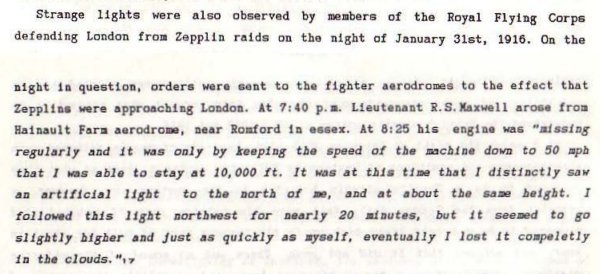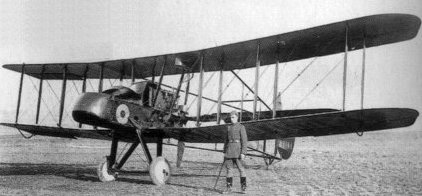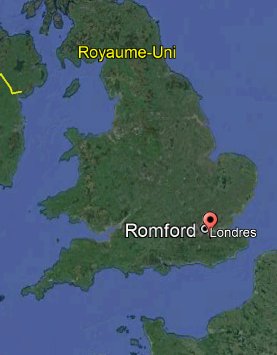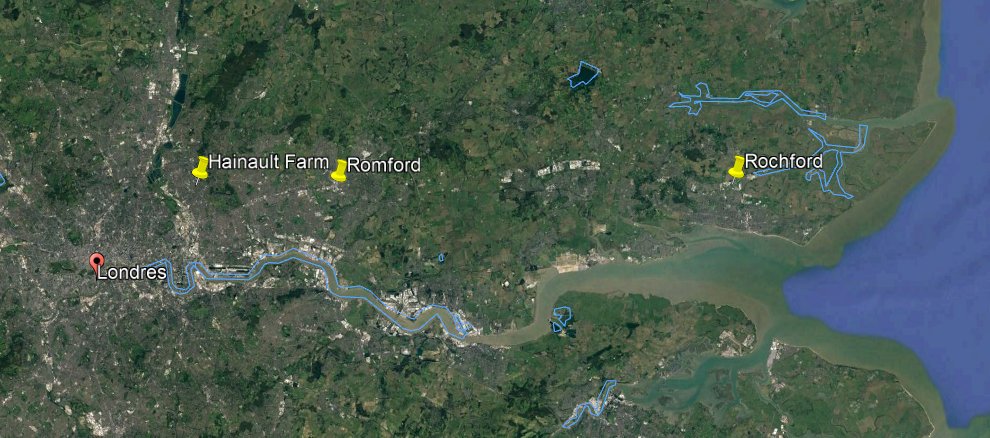ACUFO-1916-01-31-ROMFORD-1
In January 1916, Reginald Stuart Maxwell was a flying officer in the Royal Flying Corps, the forerunner of the British Royal Air Force, assigned to No. 25 Squadron, flying the two-seater push-propeller aircraft FE.2b.
On the night of January 31, 1916, orders were sent to fighter airfields indicating that Zeppelins were approaching London.
According to the Royal Flying Corps military report “PRO Air l/611 16/15/286” found by the British ufologist Dr. David Clarke, who mentioned it in 1987, R.S. Maxwell took off from Hainault Farm aerodrome, near Romford, Essex, at 7:40 p.m. At 8:25 p.m., his engine was...
“...missing regularly and it was only by keeping the speed of the engine down to 50 mph that I was able to stay at 10,000 ft. It was at this time that I distinctly saw an artificial light to the north of me, and at about the same height. I followed this light northwest for nearly 20 minutes, but it seemed to go slightly higher and just as quickly as myself, eventually I lost it completely in the clouds.”
| Date: | January 31, 1916 |
|---|---|
| Time: | 08:25 p.m. |
| Duration: | 20 minutes. |
| First known report date: | 1916 |
| Reporting delay: | Hours, days. |
| Country: | U-K. |
|---|---|
| State/Department: | Essex |
| City or place: | Romford |
| Number of alleged witnesses: | 1 |
|---|---|
| Number of known witnesses: | 1 |
| Number of named witnesses: | 1 |
| Reporting channel: | Military report. |
|---|---|
| Visibility conditions: | Night. |
| UFO observed: | Yes. |
| UFO arrival observed: | ? |
| UFO departure observed: | ? |
| UFO action: | None. |
| Witnesses action: | Attempts approach in vain. |
| Photographs: | No. |
| Sketch(s) by witness(es): | No. |
| Sketch(es) approved by witness(es): | No. |
| Witness(es) feelings: | ? |
| Witnesses interpretation: | Artificial light. |
| Sensors: |
[X] Visual: 1.
[ ] Airborne radar: N/A. [ ] Directional ground radar: N/A. [ ] Height finder ground radar: N/A. [ ] Photo: [ ] Film/video: [ ] EM Effects: [ ] Failures: [ ] Damages: |
|---|---|
| Hynek: | NL |
| Armed / unarmed: | Two Lewis 7.62 mm machine guns. |
| Reliability 1-3: | 3 |
| Strangeness 1-3: | 1 |
| ACUFO: | Possible star Capella. |
[Ref. dce1:] DR. DAVID CLARKE:

|
Strange lights were also observed by members of the Royal Flying Corps defending London from Zeppelin raids on the night of January 31st, 1916. On the night in question, orders were sent to the fighter aerodromes to the effect that Zeppelins were approaching London. At 7:40 p.m. Lieutenant R.S. Maxwell arose from Hainault Farm aerodrome, near Romford in Essex. At 8:25 his engine was “missing regularly and it was only by keeping the speed of the engine down to 50 mph that I was able to stay at 10,000 ft. It was at this time that I distinctly saw an artificial light to the north of me, and at about the same height. I followed this light northwest for nearly 20 minutes, but it seemed to go slightly higher and just as quickly as myself, eventually I lost lt completely in the clouds.” 17
The source '17' is detailed as “PRO Air l/611 16/15/286.”
[Ref. dcr2:] DR. DAVID CLARKE AND ANDY ROBERTS:
The authors indicate that strange lights were observed by members of the Royal Flying Corps defending London from Zeppelin raids on the night of January 31, 1916. In the night, orders were sent to the fighter airfield saying Zeppelins were approaching London. At 07:40 p.m. Lieutenant R. S. Maxwell took off from the Hainault Farm Aerodrome, near Romford in Essex. At 08:25 his engine was...
“... missing irregularly and it was only by keeping the speed of the machine down to 50 mph that I was able to stay at 10,000 feet. It was at this time that I distinctly saw an artificial light to the north of me, and at about the same height. I followed this light northeast for nearly 20 minutes, but it seemed to go slightly higher and just as quickly as myself... and I eventually lost it completely in the clouds.”
The authors indicate that the source is “14 PRO Air 1/611 16/15/288; Morris, James, The German Air-raids on Great Britain, 1914-18 (London, 1925).”
They comment that in those days, UFOs have been reported as both phantom airships and mystery aircraft; but in the flying saucer era mystery lights in the sky have been interpreted otherwise, and an examination of why people in particular circumstances and locations interpret lights in the sky as one type of aerial craft and not another “can help us better to understand the current UFO folklore in the Space Age.”
[Ref. prt1:] JAN ALDRICH - "PROJECT 1947":
Circa 1999, ufologist Jan Aldrich prepared a catalogue of summaries of early cases of aircraft - UFO encounters ([prt2]) that were sometimes previously unpublished or little-known. This was to help French ufologist Dominique Weinstein in compiling the latter's catalogue of aircraft - UFO encounters. Aldrich explained that as Dominique Weinstein has many of the primary documents, the summaries are very short.
N [N=New Case not in November 1997 ACUFOE Catalogue] - 1916.01.31, 2025 hours, England, Near Romford, Essex.
RAF fighter patrolling for Zeppelins saw a light to the north. He tried to close for 20 minutes but his engine was malfunctioning and would not do more than 50 mph. Light was lost in the clouds. (UFO Brigantia #25, Mar-Apr 87 (PRO Air 1/611/16/15/288) (First UFO seen from the air))
[Ref. dce2:] DR. DAVID CLARKE:
On the Web, a detailed version was published by Dr. David Clarke ([dce1]), “skeptical” British ufologist who did huge work in checking such incidents in the British National Archive file:
Early in 1916 a mysterious light in the sky was spotted and chased by a pilot of the Royal Flying Corps on patrol above the capital. On the night of January 31 the crews of nine Zeppelins of the German Navy left their sheds on the Continent with orders from their commanding officer, Peter Strasser, to “attack England middle and south.”
With their giant hydrogen-filled envelopes weighted down with explosives and incendiary bombs, the squadron of aerial monsters crossed the North Sea with plans to attack industrial targets in England. These included the important steelworks in Sheffield and Liverpool docks. However, the plan was thrown into chaos by atrocious weather conditions of freezing rain, snow and thick ground mist which shielded much of the countryside from the air and made accurate navigation impossible. Amidst much confusion secondary targets in the North and the Midlands were bombed including Birmingham, Burton-on-Trent and Scunthorpe, leaving 71 people dead and 113 injured.
Despite the confusion, the War Office was able to plot the precise course of all nine raiding airships and it has been established that none of the enemy ventured further south than the Norfolk Broads. Because intially at least one of the raiding Zeppelins turned south after crossing the East Anglian coastline, the War Office calculated that if the course was held they would be over London at 8.10 p.m. Orders to this effect were sent to the fighter aerodromes defending the capital, one of these being Hainault Farm, four miles north of Romford in Essex.
At 7.40pm Lieutenant R.S. Maxwell arose from Hainault Farm aerodrome in his BE2C fighter but saw nothing unusual until 8.25 when according to his report:
“My engine was missing irregularly and it was only by keeping the speed of the machine down to 50 mph that I was able to stay at 10,000 feet. It was at this time when I distinctly saw an artificial light to the north of me, and at about the same height. I followed this light northeast for nearly 20 minutes, but it seemed to go slightly higher and just as quickly as myself, and eventually I lost it completely in the clouds.”
At around the same time Claude Ridley, the pilot of a second BE fighter, reported seeing what he called “a moving light” in the sky over London which he followed and lost in dense cloud. It is a possibility that both Maxwell and Ridley had caught a fleeting glimpse of each other's biplanes, but it was impossible for them to confirm visual contact without radio sets. During the air-raid 16 British pilots took off in a desperate bid to engage the high-flying Zeppelins, but according to the surviving records not one succeeded in engaging the enemy. At this stage in the air war, few people outside the embryonic army and navy flying corps - which merged to create the RAF in 1918 - had any real idea of the problems involved in night-time interceptions, with take offs and landings being particularly hazardous procedures. Two of the RFC's most experienced pilots lost their lives during the course of the night, when the flimsy aircraft collided with fog-shrouded trees during their attempts to become airborne.
Confusion, inexperience and bad weather may well account for Maxwell's sighting. But what happened next, just 20 minutes later, makes an altogether different - and far stranger - interpretation of that night's events a distinct possibility.

|
The Royal Aircraft Factory F.E.2 (pictured above) was a single-engine, two-seat aircraft. The observer had a 7.62 mm Lewis machine gun firing forward, and on the F.E. version B had a second Lewis machine gun in front of the pilot's cockpit, mounted on a telescopic foot even allowing firing backwards.
Although outclassed in 1916 as a day fighter, the F.E.2 proved very suitable for use at night and was used as a night fighter in home defense squadrons on anti-Zeppelin patrols.

|
The January 31, 1916, Zeppelin raid is fully documented. It involved two Zeppelins, L21 from Nordholz in Germany and L19 from Tonder in Denmark. They were supposed to bomb Liverpool factories, a round flight of nearly 1,000 miles. Everything went well initially, but on reaching Norfolk they encountered mist and fog, and were soon lost. They both made the same navigational error, and ended up over the Black Country.
At 5:25 p.m., L21 was spotted above King's Lynn, and was seen over Derby at 6.55 p.m. It then crossed Wombourne, Kingswinford, Brierley Hill, Netherton. It arrived over Tipton around 08:00 p.m. After the bombing it headed back to its base in Germany.
L19 roughly followed L21's flight path, slower due to engine issues. It reached Tipton at about 12.30 a.m. As it crossed back the North Sea with only one engine out of three still functioning, it received rifles fire from the Dutch and came down on the sea, and the entire crew was lost.
Neither L21 nor L19 had flown over or near London. The pilots' sightings were not of any Zeppelin.
Historical sources indicate that Reginald Stuart Maxwell, born July 20, 1894, deceased July 1, 1960, claimed four victories in 1916 flying FE2b with 25 and 20 Squadrons. He later moved to 54 Squadron flying Sopwith Camels, and claimed a further 5 victories during 1918. He was gazetted for the Distinguished Flying Cross on 8th February 1919.
In January 1916 he was a flying officer assigned to No. 25 Squadron flying the “pusher” plane F.E.2b.
This is about a steady light in the sky, with only sparse in formation. It was to the North of the witness, located near London on January 31, 1916, sometime after 08:25 p.m. The night was not yet totally dark at 08:25 p.m.
It it quite obvious to me an astronomical misinterpretation cannot be entirely excluded. At the north of the witness at that date, time and place, the brightest object in the sky was the star Capella. It was at the azimuth of 347°, the low elevation of 8°, suitable for a misinterpretation of a distant light from a flying machine. The visual (BSC5) magnitude of Capella was then 0.08.
It should be noted, though, that the next pilot sighting took place near Rochford the same night at about the same time, and the location of this next sighting may be quite the same, as Romford and Rochford are only 36 km away:

|
Possible star Capella.
* = Source is available to me.
? = Source I am told about but could not get so far. Help needed.
| Main author: | Patrick Gross |
|---|---|
| Contributors: | None |
| Reviewers: | None |
| Editor: | Patrick Gross |
| Version: | Create/changed by: | Date: | Description: |
|---|---|---|---|
| 0.1 | Patrick Gross | November 8, 2023 | Creation, [dce1], [dcr2], [prt1], [dce2]. |
| 1.0 | Patrick Gross | November 8, 2023 | First published. |